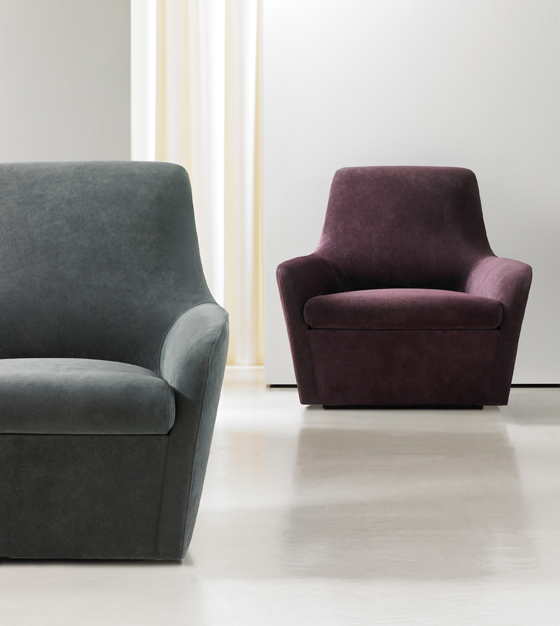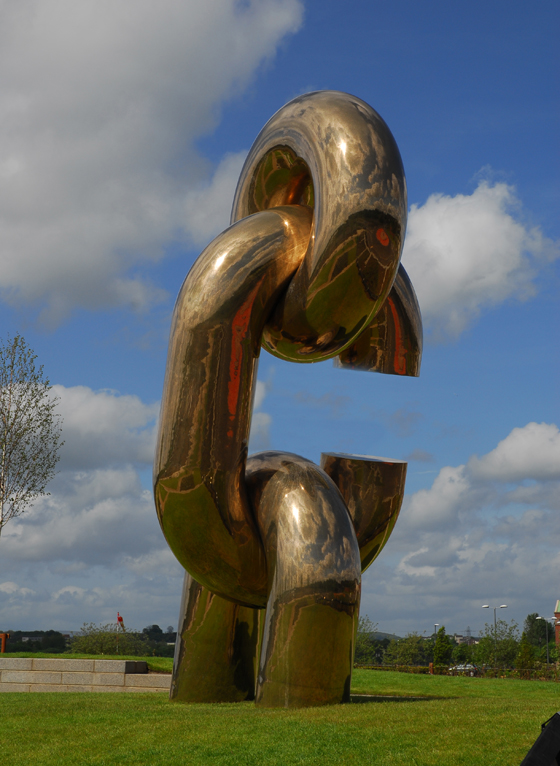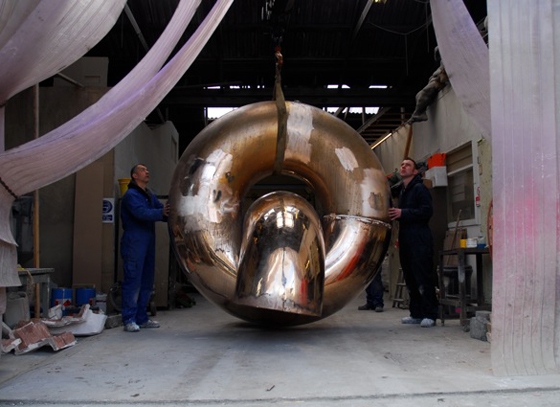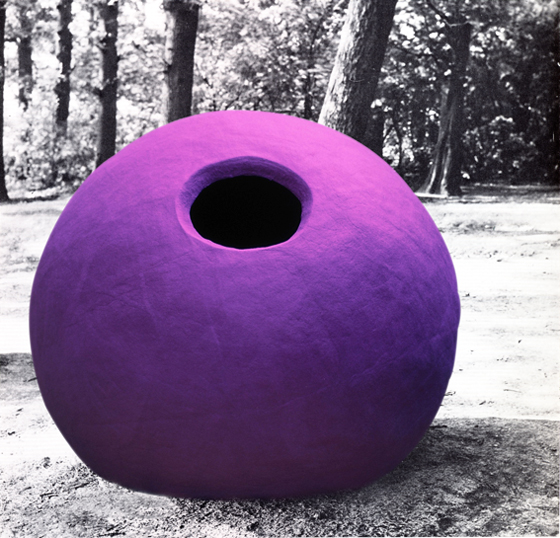Who? Me?: the multiple identities of Jephson Robb
Texto por Simon Keane-Cowell
Zürich, Suiza
15.12.10
His very first furniture design – for established American brand Bernhardt Design – is an exercise in form follows comfort. Once you're sitting on Jephson Robb's new 'Amri' chair, it's seriously hard to get up again. This invitation to stay put for a while is rather ironic, given the restless career of the Scottish artist-designer, which has seen him study at the Royal College of Art and work in London's finance sector, create a number of public artworks, design websites and develop a handy product for hairdressers. Confused? Then, read on.
Someone called Simon Cowell should probably steer clear of making quips about other people looking like celebrities. The last laugh will always be on me. When I tell Scottish artist-designer Jephson Robb, however, that he has a touch of the Hugh Grants about him, he informs me, rather graciously, I'm not the first to say this and probably won't be the last.
Scottish artist-designer's new 'Amri' chair for established American manufacturer Bernhardt Design. 'I set out to make a comfortable chair. Not to make a design statement,' says Robb

Scottish artist-designer's new 'Amri' chair for established American manufacturer Bernhardt Design. 'I set out to make a comfortable chair. Not to make a design statement,' says Robb
×Japes aside, identity is a somewhat appropriate subject when it comes to discussing Robb and his work. The Glasgow-based Royal College of Art graduate's creative practice is decidedly Renaissance: he's delivered a number of large-scale public-art projects (he's currently working on one for the town of Falkirk in his native Scotland), has a piece in MoMA's permanent collection, is an accomplished website designer, studied economics and politics and followed this with a stint in the City, and is now designing furniture, his first chair a commission from established American manufacturer Bernhardt Design. Oh, and he once developed a product for hairdressers, which stops hair falling down clients' backs. (He assures me it was a commercial success.) Robb, rather refreshingly, doesn't fit into your traditional professional typology.
He's more than OK with this, however. 'When I was at school, people would say “What do you want to be?” and whatever you chose to be that's what you'd be for the whole life,' explains Robb. 'That kind of thing doesn't really matter to me. As long as I'm making things with integrity, with passion, that's all that matters. And with humour, too.'
Glasgow-based, Royal College graduate Jephson Robb's creative career challenges traditional professional classification. 'As long as I'm making things with integrity, with passion,' he explains, 'that's all that matters'

Glasgow-based, Royal College graduate Jephson Robb's creative career challenges traditional professional classification. 'As long as I'm making things with integrity, with passion,' he explains, 'that's all that matters'
×I met up with Robb during this year's London Design Festival to discuss his collaboration with Bernhardt Design. How does someone who's used to creating large outdoor sculptural works go about designing a chair? How does the experience of the former inform the latter? And how do the commercial demands of designing for a manufacturer compare to the creative opportunity afforded by a publicly funded public-art commission? We started by sitting down...
....
It has to be said, your new 'Amri' chair is incredibly comfortable.
That's what I set out to do. To make a comfortable chair. Not to make a design statement.
How did the project come about?
Well, I'd worked with Bernhardt Design on different projects. Milan shows, their website. And I'd always said to Jerry Helling [Bernhardt Design President] that I wasn't interested in designing a chair for him. But it occurred to me that maybe I was resistant to the idea because it's a difficult job and maybe I wasn't going to be able to do it. But my thinking obviously changed.
Robb has delivered a number of large-scale artworks for public spaces. 'Change', located in Clydebank, Scotland, was completed in 2009

Robb has delivered a number of large-scale artworks for public spaces. 'Change', located in Clydebank, Scotland, was completed in 2009
×So, was it daunting?
No, it was at a point that I'd become excited about doing it. I started from personal experience. What's my experience of chairs been? Often, I've discovered that when I see a chair it often communicates to me something that is completely different from what I feel when I experience it. So, I asked myself 'What do we look for from a chair?' For me, it's comfort. Support and comfort. So, I wanted to design a chair that communicates that so that when you experience it there's no disparity between experience and expectation. That was my brief to myself.
You've worked on a number of public-art projects. How does that type of creative work relate to this?
Well, I wanted this chair to be inclusive. A chair in a commercial setting – airport lounges, banks, offices – is putting a piece of furniture in a public space. I saw a correlation between creating public art and a piece of public furniture. Often you get asked to design public furniture when you do art projects, which I don't actually do. I'm more interested in the sculpture, what form can communicate. What the idea is.
Well, that idea of the sculptural is clearly in evidence here.
The notion that it could have possibly been sculpted from the one piece – carved out of a block of marble or wood, that smoothness of form – was important. We had to work on the upholstery and foam to achieve this. There are lots of different densities of foam used to keep the fabrics tight and the comfort there, so that's not lost over time. There's a sprung system inside to keep the foam out, as well.
Construction shot: Robb's highly sculptural 'Change' public artwork for Clydebank in Scotland is made of cast bronze

Construction shot: Robb's highly sculptural 'Change' public artwork for Clydebank in Scotland is made of cast bronze
×What did you learn in the process, seeing as it was your first chair design?
I learnt a lot about what's involved in creating comfort in a chair, primarily. How it's not one pitch of a chair that's the perfect pitch. Everyone is slightly different. It's about allowing a chair to create that variation within itself. So that's what I'll be looking at for my second chair project.
Returning to your public-art projects, beyond the clear difference in terms of scale between large, outdoor pieces of sculpture and a piece of furniture designed for use inside, how does the actual process of working on the former inform that latter? Does it at all?
A lot of the projects I've worked on are of a significant scale. But they're not non-human. A five-metre-high bronze is a lot of material, but it's still human. It has a lot of interaction between my sculptural work and the human being, when they view it, when they engage with it. In that way there's a similarity, creating an object based on a direct interaction. This chair has a direct relationship to an earlier piece of mine called 'Cries & Whispers' which is in MoMA's permanent collection, and which is about creating comfort and security.
Material obviously plays a role there. It's made of felt.
Yes. And that piece was on a very human scale. Although it's more conceptual than functional, it has a very strong link to the chair. But there are obvious differences at the same time. But I didn't it difficult to adjust to making furniture in terms of scale. One of my earlier objects was called 'A Smile Maker', which is five elastic bands and two paper clips. It's a small thing, but the idea behind it is a big one – a mechanical device to make people smile. As opposed to taking anti-depressants. Although I'm not prescribing that people stop taking anti-depressants...
'Cries & Whispers' from 2005 by Jephson Robb. The piece is now part of MoMA's permanent collection

'Cries & Whispers' from 2005 by Jephson Robb. The piece is now part of MoMA's permanent collection
×I can see the headline now.
(Laughs.) There's a human scale in all of my work. It's got to be about the human condition all the way through. And comfort is central to this. There are very few people who want to walk about wearing hair shirts.
Are there other thematics, though, that you are interested in exploring through furniture design?
The ideas of creation and destruction are very present in my work in general, so I'm very open to engaging with how this informs my future furniture projects. I'm open to all kinds of creative challenges, developing any thematic that seems appropriate.
But how much room is there creatively to explore when you're designing for a manufacturer? I mean, it's fundamentally a commercial act. It's surely very different from creating a public artwork that is publicly funded. A design manufacturer ultimately has to sell the product. And in volume.
Well, it's about being appropriate to the context in which you're working. You have to know who you're working with and who you're working for. As an artist you're working for yourself. As a designer for your client. The furniture manufacturer has to make a profit, be that a financial one or a marketing gain. That said, in public art you are trying to add value through your work to a site. Often public art is used as part of a regeneration or a transformation of a place. It's about taking a finite resource – otherwise known as the budget – and creating as much infinite value over a long period of time. So the end product may be different from a commercial context, but there's a big fit also.
'Wonder', consisting of hessian sandbags, was constructed in 2007 on Edinburgh's Portobello beach
It's interesting that your background isn't a formal design one. You studied Politics and Economics.
I did. Partly because I didn't understand what was being said in the newspapers. Inflation...
Don't look at me. I still don't. (Laughs.)
Well, I have more of an understanding now. That's what motivated me to do it. Then I took a job in the City, but resigned as I realised it wasn't what I wanted to be doing. And then I designed a product off my own bat for hairdressers, to stop hair going down your neck. Very functional. It was very successful commercially. Based on the simple function of a dry-suit neck seal. It was selected to be part of the Glasgow Collection, which was part of the Lighthouse, Scotland's centre for architecture and design. And that was with no training at all. Then I went and did a master's in Design Products at the Royal College of Art. While I was there, Tord Boontje, who was my tutor, commissioned my first piece of design-art for the British Council's touring exhibition of China. I hadn't the five years background of a BA degree in design that a lot of the other students had, so I was always asking questions.
I think it's a positive advantage if you don't have a linear background, and you've not been institutionalised, coming to a practice like product design. You bring all sorts of other types of knowledge and experience to it that other, single-track designers don't have.
In a way they have a lot of the skills that I don't have. But I can buy in those skills. Whereas it's perhaps harder for them to buy in life experience. That's the thing you gain over time. But my life experiences are available for hire. (Laughs.)
You won't be going back to the City any time soon?
(Laughs.) No, I think there are a lot of people trying to get out of the City at the moment.
Jephson, many thanks.
.....






